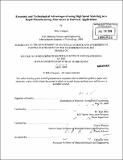Economic and technological advantages of using high speed sintering as a rapid manufacturing alternative in footwear applications
Author(s)
Vasquez, Mike (George Mike)
DownloadFull printable version (22.55Mb)
Alternative title
Advantages of using high speed sintering as a rapid manufacturing alternative in footwear applications
Other Contributors
Massachusetts Institute of Technology. Dept. of Materials Science and Engineering.
Advisor
Kim Blair and Edwin Thomas.
Terms of use
Metadata
Show full item recordAbstract
Rapid manufacturing is a family of technologies that employ additive layer deposition techniques to construct parts from computer based design models.[2] These parts can then be used as prototypes or finished goods. One type of rapid manufacturing technology, Selective Laser Sintering, only allows for a point-by-point sintering process to construct the 3D representations of CAD models. This makes for long processing periods and is ineffective for high volume manufacturing. However, a new process called high-speed sintering uses infrared energy to 'flash' the polymer powder at multiple points making the layer deposition process much more time efficient. In effect each infusion of energy results in an entire layer being constructed rather than a single point. One of the first industrial applications for this technique is in performance footwear manufacturing. New Balance, a Boston based shoe and apparel company, in collaboration with Loughborough University has an interest in exploring the technology for low volume parts manufacturing as well as personalized footwear. High speed sintering has the potential to replace injection molding for specific footwear and non-footwear applications. This technology has several key advantages over injection molding including the ability to build complex geometries that would be impossible with injection molding. Also as the technology continues to evolve new materials could improve the mechanical performance of finished parts. Nevertheless, as with commercializing any new technology identifying a cost effective implementation route is a pivotal step. (cont.) This project addressed this concern by thoroughly investigating the current and potential state of high speed sintering. The manufacture of a New Balance shoe part using both high speed sintering and injection molding was directly compared. Several factors including time to manufacture and cost were investigated.
Description
Thesis (M. Eng.)--Massachusetts Institute of Technology, Dept. of Materials Science and Engineering, 2009. "May 2009." Cataloged from PDF version of thesis. Includes bibliographical references (p. 52-54).
Date issued
2009Department
Massachusetts Institute of Technology. Department of Materials Science and EngineeringPublisher
Massachusetts Institute of Technology
Keywords
Materials Science and Engineering.